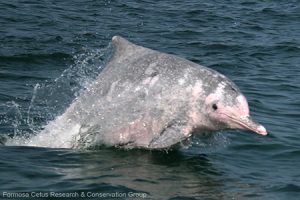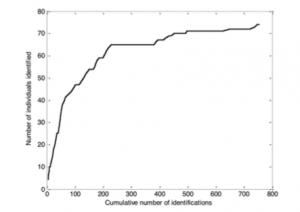Social structure in a critically endangered Indo-Pacific humpback dolphin (Sousa chinensis) population
by Robbie Roemer, SRC student
It is sometimes hard to comprehend animals besides humans, have the ability to ‘socially learn’ having complex social structures within their animal community. But such is the case with a variety of species including: lemon sharks (Guttridge et al. 2012; Guttridge et al. 2009), a variety of marine mammals (Krützen et al. 2005), and most astonishingly, the common crow (Hunt and Gray 2003). Recently published in the journal of Aquatic Conservation: Marine And Freshwater Ecosystems, a new study investigated the social structure and behavior of a critically endangered Eastern Taiwan Straight (ETS) population of Indo-Pacific humpback dolphin.
In a sense, social behaviors are an assembly of strategies that increase the probability of survivorship and reproductive potential (fitness). Examples of social structure can include successful foraging, predator defense, and learning integral survival skills. As such, the linkages between social structure and species population status can have integral conservation implications. For some time, cetaceans (order of mammals including whales and dolphins) have been noted to have a wide variety of social behaviors. Concurrently, populations of cetaceans have been over-exploited and are encountering a wide array of anthropogenic stressors.
The Indo-Pacific humpback dolphin (Sousa chinensis) is an estuarine population constricted to the west coast of Taiwan, thus making it genetically different than other populations of Indo-Pacific humpback dolphin. This population is relatively small, and almost always observed no further than 3 km from the shoreline. A population this small and isolated may have inherent benefits to having a more cohesive and less flexible social structure. This makes sense considering it would allow for easier transmission of information critical to the survival of the species (i.e. location of prey, predator avoidance, etc.). However, the down side of such a small population in close proximity to shore makes this species extremely vulnerable to anthropogenic threats including habitat loss, and habitat degradation from the process of development.
In this study, scientists conducted surveys within the near-shore waters of western Taiwan during the summers of 2007 to 2010. The scope of the project was essentially a mark-recapture study design. When an individual was spotted, the team slowly moved close, taking photographs of both sides of the dolphin. After each survey, photographs were analyzed to identify individuals to an ongoing species catalogue that has been accumulating since 2002. The Eastern Taiwan Straight population of humpback dolphin possesses a unique pattern of spotting, acting almost like a fingerprint, allowing researchers to discern individuals within the overall population. This same unique pattern of spotting is retained their entire lives, and lets researchers photographically identify an individual throughout the dolphins entire lifespan.

An Indo-Pacific humpback dolphin surfaces. Note the extensive and unique spotting pattern (Photo credit: Formosa Cetus Research and Conservation Group)
ETS dolphins were considered associated if they were observed in the same group and were actively participating in common behaviors like feeding or traveling. Detailed statistical analysis allowed researchers to investigate several key metrics with obtained data. Relationships between individuals were calculated using an equation called an Association Index or ‘AI’, which was evaluated within a statistical software package. Without getting too detailed, this formula gave researchers a representation of social structure in an association matrix. This matrix then permitted researchers to test for preferred and avoided associations within the population. Modularity (Q), was represented as the difference between observed and expected associations between clusters, Q-values greater than 0.3 is an accurate representation of social division. Other metrics included utilizing a network analysis statistical toolset to determine basic properties of networks (social or otherwise), and effect of calf presence on association patterns. Network analysis examined grouping strength, reach, and clustering coefficients.
With highly interconnected, ‘tight-knit’ cohesive social networks, the aforementioned parameters tend to be significantly greater than those values encountered at random. To determine if calf presence had any effect on association patterns, scientists divided sightings into two groups, depending on if a calf was also sighted. Through even more statistical analysis (randomized permutation tests) scientists could inspect whether there was a difference in mean group size between the presence and absence of calves.
Results:
A total of 74 individual dolphins identified in 121 sightings during the sampling period with a sum of 928 total photographs. Group sizes ranged from single individuals to groups of 31 dolphins, with each of the 74 dolphins in the study sighted at least twice. Permutation tests indicated both preferred and avoided long-term social associations. Mathematical modeling showed short-term associations dissipated in less than a day, while long-term associations only started to drop off after 10 years! Cluster analysis discovered no obvious clustering (tightly knit groups within a group) and no strong social divisions within the population but alternatively, showed a strong centrally dense structure. Group sizes were larger in the presence of a calf, with a significantly larger clustering coefficient.

Graph depicting the accumulation of new individuals spotted over the entire study period (Dungan et al. 2015).
So what exactly does this data tell us?
Firstly, the researchers have determined that the ETS population of humpback dolphin is a social network primarily characterized by cohesion and long-term stability. For most dolphin species, displaying these characteristics is very rare occurrence. Other research on bottlenose dolphins have suggested that long-term stability and cooperation may exist only in confined isolated regions to maximize the transmission of information such as successful foraging techniques which are vital to the survival of the species (Rendell and Whitehead, 2001). The authors propose this could be the case for the ETS humpback population as well, considering the extremely anthropogenically depleted environment of the western coast of Taiwan, and the isolated population of ETS humpback dolphins. Lastly, it seems mother and claves in the ETS humpback population are critical to the maintenance of the entire social structure. Through the aforementioned statistical analyses, it is inferred this subpopulation of humpback dolphins may indeed utilize nursery groups where breeding females actually maintain cooperative care for the calves. This adaptation has several benefits including increasing the overall ecological fitness of the calf (thereby increasing overall offspring survivorship) as well as giving a chance to young/newly mature females to practice mothering behavior. The authors also attribute this communal behavior as a result of the subpopulation living in such degraded habitats.
References
Dungan, S. Z., Wang, J. Y., Araújo, C. C., Yang, S. C., & White, B. N. (2015). Social structure in a critically endangered Indo‐Pacific humpback dolphin (Sousa chinensis) population. Aquatic Conservation: Marine and Freshwater Ecosystems.
Guttridge, T. L., van Dijk, S., Stamhuis, E. J., Krause, J., Gruber, S. H., & Brown, C. (2013). Social learning in juvenile lemon sharks, Negaprion brevirostris. Animal cognition, 16(1), 55-64.
Guttridge, T. L., Gruber, S. H., Gledhill, K. S., Croft, D. P., Sims, D. W., & Krause, J. (2009). Social preferences of juvenile lemon sharks, Negaprion brevirostris. Animal Behaviour, 78(2), 543-548.
Holzhaider, J. C., Hunt, G. R., & Gray, R. D. (2010). Social learning in New Caledonian crows. Learning & Behavior, 38(3), 206-219.
Krützen, M., Mann, J., Heithaus, M. R., Connor, R. C., Bejder, L., & Sherwin, W. B. (2005). Cultural transmission of tool use in bottlenose dolphins. Proceedings of the National Academy of Sciences of the United States of America, 102(25), 8939-8943.
Hunt, G. R., & Gray, R. D. (2003). Diversification and cumulative evolution in New Caledonian crow tool manufacture. Proceedings of the Royal Society of London B: Biological Sciences, 270(1517), 867-874.
Rendell LL, Whitehead HH. 2001. Culture in whales and dolphins. Behavioral and Brain Sciences 24: 309–382.
